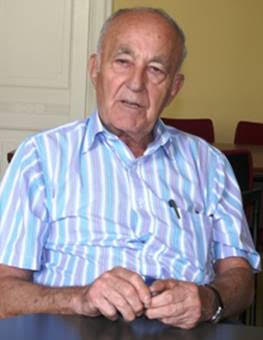
THE VOICE OF INTERNATIONAL LITHUANIA
|
VilNews has its own Google archive! Type a word in the above search box to find any article.
You can also follow us on Facebook. We have two different pages. Click to open and join.
|
Archive for November, 2012
- Posted by - (0) Comment
|
|
24 NOV – 26 DEC 2012 |
|
|
Kaunas, Lithuania's second largest city and former capital, is receiving much attention in VilNews now as 2012 is coming to an end. We focus on history, business, culture, innovation, tourism and more. We would also like to hear from you who have your personal Kaunas story to tell... Send us your Kaunas story!
|
||
|
Thinking of business?
|
||
- Bookmark :
- Digg
- del.icio.us
- Stumbleupon
- Redit it
- Posted by - (0) Comment
Kitron to invest in Kaunas
instead of China, Norway
One of the leading electronics manufacturing services suppliers in Scandinavia – Kitron – will expand its manufacturing facility in Lithuanian city Kaunas, and invest almost six million euros into this project, the Invest in Lithuania reports now in November.
The expansion strategy of the Norwegian company in Lithuania encompasses an increase in its production capacity, the creation of 60 new job openings and an improvement to the company's revenue by 40%, writes LETA/ELTA.
In Kaunas, Kitron already produces electronic control systems for high-speed rail vehicles and electric grass mowers, electronic circuits for ultrasound devices, scientific equipment for seabed research, mobile blood test devices, smart grid/automatic meter reading systems and other electronic equipment.
"To win this expansion project, Lithuania competed with the US, Norway and China, all of which are well-known to Norwegian investors as countries where they have already established manufacturing facilities. Our country [Lithuania] was chosen because of its convenient location for logistics, the low costs of labor, and the resources to ensure production quality. Since the Norwegian company also supplies its goods to the defense and medical equipment industries, qualitative criteria were important to the decision on location," said the Managing Director of Kitron Lithuania, Mindaugas Sestokas.
- Bookmark :
- Digg
- del.icio.us
- Stumbleupon
- Redit it
- Posted by - (1) Comment
|
|
KAUNAS IN FOCUS 24 NOV – 26 DEC 2012 |
|
|
Kaunas, Lithuania's second largest city and former capital, is receiving much attention in VilNews now as 2012 is coming to an end. We focus on history, business, culture, innovation, tourism and more. We would also like to hear from you who have your personal Kaunas story to tell... Send us your Kaunas story!
|
||
|
Thinking of business?
|
||
|
Kitron to invest in Kaunas
|
||
- Bookmark :
- Digg
- del.icio.us
- Stumbleupon
- Redit it
- Posted by - (0) Comment
Kaunas FEZ – the ideal
place for new business
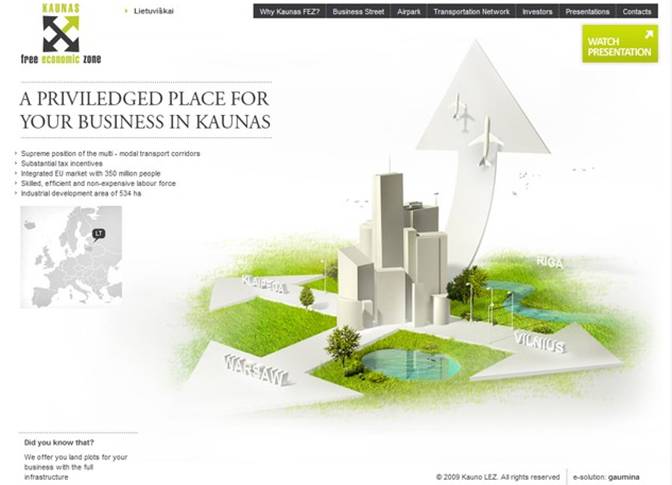
Kaunas FEZ (Free Economic Zone) is a 534 ha industrial
development area which offers tax incentives.
Key advantages include:
· Considerable tax incentives;
· Excellent geographic location, coupled with high quality road and railroad connections;
· Adjacent to Kaunas Airport (at present 17 flight directions to the Western European Countries) ;
· Close to ice-free Klaipeda Seaport;
· Stable and constantly growing Lithuanian economy;
· Highly skilled and inexpensive workforce;
· Well developed infrastructure;
· Inconsiderable cultural and linguistic barrier;
· Good investment climate;
· Safety of business in the FEZ.
Watch presentation of the Kaunas FEZ:
http://www.ftz.lt/index.php/presentation/183?vid=60
For more information, see: www.ftz.lt
- Bookmark :
- Digg
- del.icio.us
- Stumbleupon
- Redit it
- Posted by - (0) Comment
Kaunas FEZ – the ideal
place for new business
Kaunas FEZ (Free Economic Zone) is a 534 ha industrial development area which offers tax incentives.
Key advantages include:
· Considerable tax incentives;
· Excellent geographic location, coupled with high quality road and railroad connections;
· Adjacent to Kaunas Airport (at present 17 flight directions to the Western European Countries) ;
· Close to ice-free Klaipeda Seaport;
· Stable and constantly growing Lithuanian economy;
· Highly skilled and inexpensive workforce;
· Well developed infrastructure;
· Inconsiderable cultural and linguistic barrier;
· Good investment climate;
· Safety of business in the FEZ.
Watch presentation of the Kaunas FEZ:
http://www.ftz.lt/index.php/presentation/183?vid=60
For more information, see: www.ftz.lt
- Bookmark :
- Digg
- del.icio.us
- Stumbleupon
- Redit it
- Posted by - (0) Comment
Electric cars made
in Lithuania!
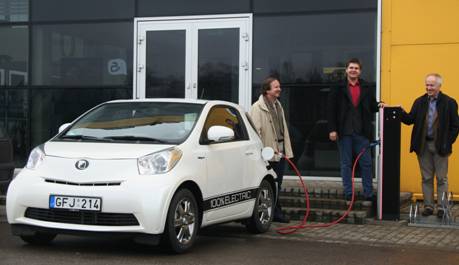
Kaunas electronics manufacturer ELINTA has come a long way in developing a new electric car here in Kaunas. These three gentlemen
are behind the success: Dr. Vytautas Jokužis, Laurynas Jokužis
and Dr. Vladas Lašas.
Elinta is a company that combines electronic with intellect. The company was established in 1991, as a research and production firm. From the start the company’s main hall mark was A highly skilled team, high quality goods and services. The business strategy, based on designing high-tech and consumer-friendly automated control systems, allowed the company to develop fast and surpass its competitors.
- Bookmark :
- Digg
- del.icio.us
- Stumbleupon
- Redit it
- Posted by - (3) Comment
Electric cars made in Lithuania!
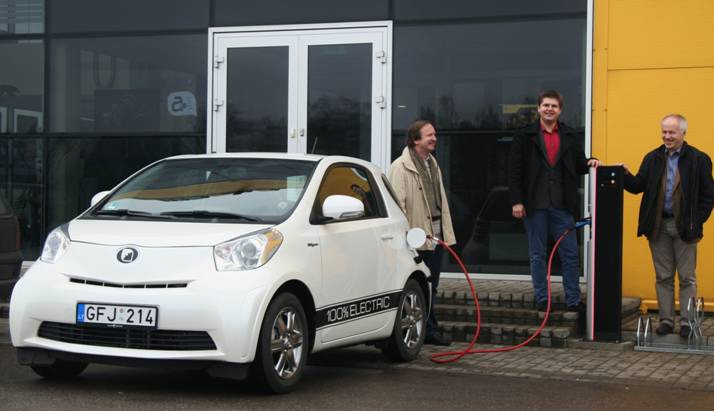
Kaunas electronics manufacturer ELINTA has come a long way in developing a new electric car here in Kaunas. These three gentlemen are behind the success: Dr. Vytautas Jokužis, Laurynas Jokužis and Dr. Vladas Lašas.
Since 1994 Elinta has also been selling products from some of the most advanced European companies. They were the first to bring the products of SIEMENS, PHOENIX CONTACT, and RITTAL to Lithuania.
With time Elinta gained significance in the field of Lithuanian industry automation. With the aim to optimise its performance ELINTA modernised its organisation by relocating different types of activities to secondary companies: UAB Elinvision, UAB Elintos matavimo sistemos, UAB Elinta VS.
As a mother company, UAB Elinta coordinates the activities of its subsidiaries. It is involved in scientific-research work, employee training and other fields, necessary for the activities of the Company Group. Currently Elinta has Sales Department which sells automation elements, and an Assembly Department which assembles automation and electricity cabinets.
UAB Elinta VS is a manufacturing company, involved in technological process automation. The main areas for automation activities include heat and electricity production, water supply and cleaning, waste disposal, production of sugar, artificial fertilizers, bio fuel, and etc. The company performs designing, programming, management systems implementation and maintenance work. One of the projects was Kaunas wastewater treatment plant.
UAB Elinvision designs and produces computer vision systems, signal measurement and processing systems. These systems can be successfully applied in automation of production quality inspection in a number of industries. The company produces three-dimensional scanners (3D) for production of orthopaedic and regular shoes and granule size monitoring systems for fertiliser industry. 3 D scanners are knownmore than in 30 countries around the world.
UAB Elintos MS supplies measurement and calibration equipment, process calibrators, testing and adjustment systems, data collection instruments and feeding sources for industrial enterprises.
Elinta has always been an inovative company, suggesting new ideas, solutions for interprises and society. Latest idea that has grown from a project to real creation is Elinta Electric vehicle. Elinta was the company that established the first electric vehicle charging point in Lithuania
Company CEO dr. Vytautas Jokužis and his colleague Vladas Lašas pays a lot of attention to ideas of young scientists, implementation and promotion of entrepreneurship. They inspire young people to create new technologies, innovative ideas.
Now Elinta has grown to company that has about 80 employees, always active in taking part in different innovative projects, collaborates with universities, always open to the society.
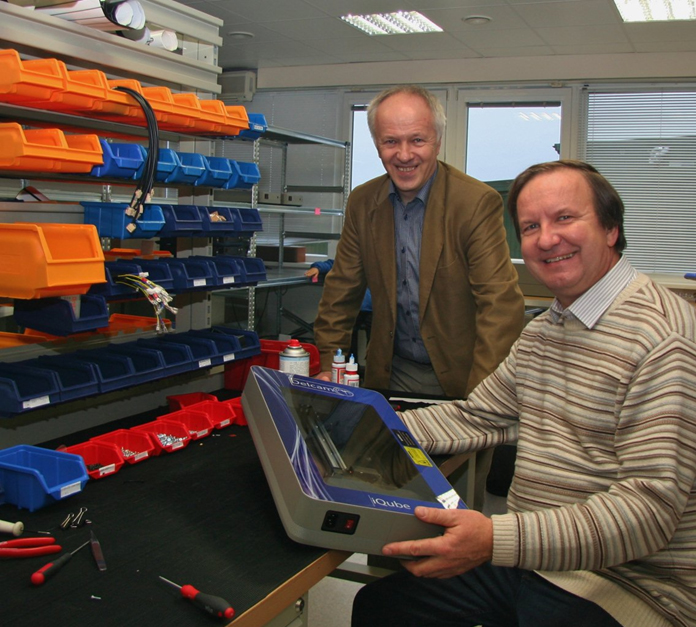
Dr. Vytatuas Jokužis and Dr. Vladas Lašas with one of the company’s new intelligent products, a three-dimensional scanner (3D) for production of orthopaedic and regular shoes
- Bookmark :
- Digg
- del.icio.us
- Stumbleupon
- Redit it
- Posted by - (0) Comment
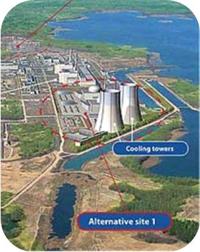
The Visaginas power station must be built!
By Mindaugas Gedgaudas
Newhall, California
Read this article from the recent issue of World Nuclear News.
The campaign to thwart the construction of a nuclear power plant in Lithuania was and continues to be orchestrated by Russia; Russia is, and has been throughout history, determined to absorb the Baltic Nations, particularly Lithuania into their imperium.
Today, Lithuania is nearly 100% dependent on Russia for sources of fuels to generate electricity; if a new nuclear power station is not built in Lithuania, all electricity will soon be coming from Russian plants, and then we will not only be totally dependent on Russia's whims, but will also be paying them - as we already do - to continue lulling us to eventually accept the imposition of their imperial dominance. What wars, terrorism, subjugation, murder, brainwashing, denial of human rights failed at, the simple matter of control of electric power just may lead to success. It is not for nothing that Russia demanded to remain as occupants of the Kaliningrad region and eventually annexed it; it is not goodwill towards the Baltic States that caused them to build a large power station next door to Lithuania; that was done with the clear intent of drawing Lithuania into their hegemony and so obliterating it as a sovereign people.
Nuclear power is the only method available to Lithuania to have a non-polluting, nearly inexhaustible and cheap source of electricity without dependence on the governments of the surrounding states. The Visaginas power station must be built and interference with its progress must be countered.
Mindaugas Gedgaudas
Newhall, California
- Bookmark :
- Digg
- del.icio.us
- Stumbleupon
- Redit it
- Posted by - (0) Comment
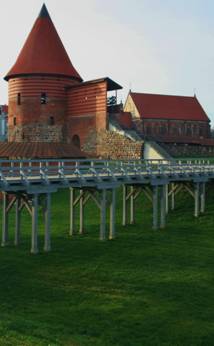
Kaunas may become European Green Capital of 2015
The competition for the prestigious award in 2015 will involve two cities of the United Kingdom – Bristol and Glasgow, also Brussels (Belgium), Bydgoszcz (Poland), Dublin (Ireland), Kutahya (Turkey) and Ljubljana (Slovenia), writes LETA/ELTA.
"The idea was initiated several years ago by Tallinn and it soon gained momentum. Every year the European Capital of Culture is announced, and now in addition to that we have a different European Green Capital elected every year. Several representatives of different European cities in a meeting in Brussels urged Kaunas to seek the award of the greenest capital in Europe. What is more, foreign guests often note that Kaunas is a very green city," said Kaunas Mayor Andrius Kupcinskas.
The title of the European Green Capital is given to a city leading environment-wise. An international commission of experts technically evaluates the candidates according to 12 criteria: climate change and energy efficiency, sustainable local transport, air quality and noise-pollution, green urban areas and sustainable use of land, nature and biodiversity conservation, waste management, water consumption and sewerage, eco-innovations and sustainable employment, as well as environmental management practice of the local government.
- Bookmark :
- Digg
- del.icio.us
- Stumbleupon
- Redit it
- Posted by - (0) Comment
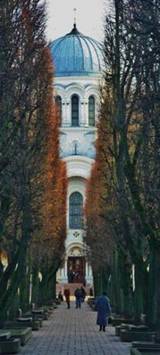 |
KAUNAS IN FOCUS Kaunas, Lithuania's second largest city and former capital, is receiving much attention in VilNews now as 2012 is coming to an end. We focus on history, business, culture, innovation, tourism and more. We would also like to hear from you who have you personal Kaunas... Send us your Kaunas story! |
Kaunas – the feel of
traditional Lithuania
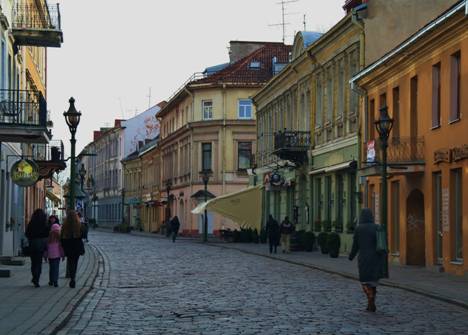
Vilniaus gatve (above), the Kaunas Old Town’s main street, was back in the 13th century a highway linking the city with Vilnius.
Read more at http://en.wikipedia.org/wiki/Centras_(Kaunas)
Text and photos: Aage Myhre
It was in 1408 that Lithuania’s Grand Duke Vytautas the Great granted Magdeburg rights to Kaunas, and after that point in time this settlement at the confluence of the Neris and Nemunas rivers began to grow as an important centre and main port for Lithuanian trade with Western Europe.
The original settlement, where today’s Kaunas old town is located, was first mentioned by the chroniclers in 1361, and it was here in the old town the first brick castle was built by the end of the 14th century, to defend Kaunas from the Crusaders’ attacks.
- Bookmark :
- Digg
- del.icio.us
- Stumbleupon
- Redit it
- Posted by - (0) Comment
|
KAUNAS IN FOCUS 24 NOV – 26 DEC 2012 Kaunas, Lithuania's second largest city and former capital, is receiving much attention in VilNews now as 2012 is coming to an end. We focus on history, business, culture, innovation, tourism and more. We would also like to hear from you who have a personal Kaunas story. Send us your Kaunas story!
|
Kaunas – the feel of
traditional Lithuania

Vilniaus gatve (above), the Kaunas Old Town’s main street, was back in the
13th century a highway linking the city with Vilnius.
|
KAUNAS OLD TOWN has a lot of surviving Gothic, Renaissance and Baroque buildings. Many notable buildings and facilities are located here, such as the Kaunas Town Hall, the Kaunas Castle and the Historical Presidential Palace, House of Perkūnas, also the Kaunas Cathedral, the Church of St. Gertrude, Vytautas' church and many other churches. Great variety of museums, such as Museum of the History of Lithuanian Medicine and Pharmacy, Povilas Stulga Museum of Lithuanian Folk Instruments, Maironis Lithuanian Literature Museum, Communication History Museum, Museum of Gemology and Kaunas City Museum. The largest seminary in Lithuania - Kaunas Priest Seminary is located at the westernmost part of the Old Town. Read more at http://en.wikipedia.org/wiki/Centras_(Kaunas) |
Text and photos: Aage Myhre
It was in 1408 that Lithuania’s Grand Duke Vytautas the Great granted Magdeburg rights to Kaunas, and after that point in time this settlement at the confluence of the Neris and Nemunas rivers began to grow as an important centre and main port for Lithuanian trade with Western Europe.
The original settlement, where today’s Kaunas old town is located, was first mentioned by the chroniclers in 1361, and it was here in the old town the first brick castle was built by the end of the 14th century, to defend Kaunas from the Crusaders’ attacks.

Kaunas castle is the oldest masonry castle in Lithuania. It was first mentioned in documents in year 1361 http://en.wikipedia.org/wiki/Kaunas_Castle
In 1441, Hansa merchants opened an office in Kaunas, and this marked the beginning of a very dynamic growth for the town. By the end of the 16th century, Kaunas had its first school, public hospital and chemist shop, and was fast becoming one of the most developed towns in all the huge Grand Duchy of Lithuania.
However, during the 17th and 18th centuries, Kaunas was to travel through a long period of hardship and hostility, not least because of attacks by the Russian army in 1655, the Swedish march to Russia in 1701, plagues in 1657 and 1708, as well as devastating fires in 1731 and 1732.
At the end of the 18th century, the fortunes of Kaunas revived a little but only until 1812, the year that saw Napoleon's army cross the Nemunas River in Kaunas on their path to Vilnius and later Russia. Heading towards the end of the 19th century, Kaunas experienced several major developments that helped it back onto a path of prosperity and growth; developments such as the opening of the Oginsky canal connecting the Nemunas and Dnieper rivers; the railway connecting the Russian Empire and Germany that was built in 1862, and the opening of the first power plant in 1898.

Napoleon's Army Crossing the Nemunas at Kaunas 24 June 1812
Wood carving. Artist: Dž. Bagetti. Carver: I. Klauberis
The First World War stemmed the further development of Kaunas mainly because of the Tsar occupation, which meant Kaunas lost its independence until 1919. With Vilnius occupied by Russia in the same year, the State Council and Cabinet of Ministers moved and established themselves in Kaunas. The following years, with Poland occupying Vilnius, Kaunas became the capital and the most important city of Lithuania governed by its first Burgomaster, Jonas Vileisis; a period considered by many as the golden age of the city. In 1920, the national parliament (Seimas) gathered in Kaunas and laid the basis for the country's legal and parliamentarian system. Over the next few years Kaunas once again experienced rapid economic and industrial growth and a significant increase in population. In 1924 the first buses appeared in Kaunas, and in 1928 plumbing was installed in most of the city's buildings.
After the Second World War, Kaunas suffered further during the forty years of Soviet occupation, as many buildings and signs of Lithuanian independence were demolished or removed. One of the world’s first public protests against the Soviet rule was in 1972, when a young man, Romas Kalanta, set himself on fire in the square in front of the Musical Theatre of Kaunas. In 1988, upon the rising of the liberation movement, many city sights were revived: streets and museum names were returned, and many monuments of independence times were restored.


One of the world’s first public protests against the Soviet rule was in 1972, when a young man, Romas Kalanta, set himself on fire in the square in front of the Musical Theatre of Kaunas. http://en.wikipedia.org/wiki/Romas_Kalanta
Since independence, Kaunas has established close links to western countries and companies, and with Lithuania having one of the fastest economic growth rates of the new EU member states, Kaunas has most certainly been one of the powerhouses of industry that has helped produce such an impressive economic climate in the country today. Kaunas has come a long way and it shows no signs of slowing down!
The excellent location of Kaunas in the very centre of Lithuania is certainly one of its main advantages, situated as it is on the crossroad of the main Lithuanian transport flows. Two main highways cross the city - Via Baltica, which connects Helsinki and Warsaw, and the highway that connects Vilnius and the port city of Klaipeda. A more an more important international airport is contributing to Kaunas’ attractiveness as the point that connects Lithuania to the world.
The long traditions of higher education is today being actively utilised as a base for Kaunas new profile as “the intelligent city” with special focus on areas like IT and development of companies, research institutions and programmes that support a dynamic and innovative economy.
The basketball team Žalgiris with its famous player Arvydas Sabonis, as well as other baskeball and other sports have put Kaunas on the world map
Kaunas is the second biggest city in Lithuania with the total area of 155.5 sq. km. and a population of approximately four hundred thousand.
The today’s Kaunas old town is a fascinating combination of archaeology, architecture and history. Here one finds the remains of a castle dating back to the 13th to 16th centuries standing as evidence of the ancient battles between Lithuania and the knights of the Teutonic Order. Numerous other buildings crowd together in a stimulating mixture of the arts and architecture of different eras. The 15th century produced the church of Vytautas, Saint George's church and the reconstructed Cathedral. City Hall, dating from the 16th to 18th centuries, is surrounded by charming old houses; the Perkūnas (Thunder) House dates back to the 15th century. Some of the city's structures are recognized as representing a distinct variation of the Northern European Renaissance style, notably the Church of the Holy Trinity and the Masalskis Manor complex (16th to 18th century).
The most outstanding baroque monument is the Paxaislis monastery, a collection of buildings dating from the 17th and 18th centuries. This is among the most lovely examples of ecclesiastical architecture in Northern Europe, unified architecturally by its hexagonal design and a majestic cupola, with its façade proportioned according to the principles of Italian baroque, and its interior decorated with subtly coloured frescoes and statues.
Kaunas is a city of very old and established cultural traditions and a place where generations of Lithuanian artists, composers and writers lived and have left their imprint. Their works are on display in various museums and galleries, of which two are especially notable. The Art Gallery of M. K. Čiurlionis displays the work of this great painter and composer, who earned his place in the history of art.
It is possible to review Lithuania's history from its prehistory to the present day, at the Military Museum of Vytautas the Great. Among the most interesting exhibits is a memento of an early transatlantic flight - a wreck of the "Lituanica." In this plane, two pioneering Lithuanian aviators, Steponas Darius and Stasys Girėnas, flew non-stop from New York in 1933, sadly crashing in German territory, not far from their final destination in Lithuania.
Kaunas is Kaunas!
Some Kaunas images
Photos: Aage Myhre

The Town Hall of Kaunas (Lithuanian: Kauno rotušė) in the Town Hall Square, also called "The white swan". The structure dates from the 16th century. Today used for wedding ceremonies and official events.
Read more at http://en.wikipedia.org/wiki/Town_Hall,_Kaunas























- Bookmark :
- Digg
- del.icio.us
- Stumbleupon
- Redit it
- Posted by - (0) Comment
Independent Lithuania
(1918–1940)
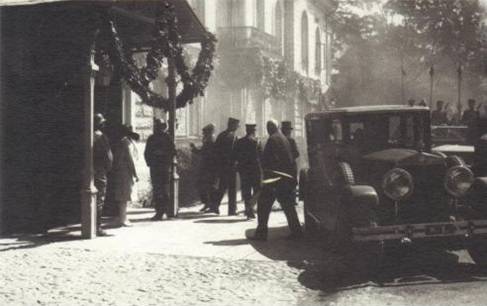
After Vilnius was occupied by the Russian Bolsheviks in 1919, the government of the Republic of Lithuania established its main base in Kaunas. Later, when the capital Vilnius was forcibly annexed by Poland, Kaunas became the temporary capital of Lithuania,a position it held until 28 October 1939, when the Red Army handed Vilnius back to Lithuania. Here a picture from the Presidential Palace of the Republic of Lithuania in Kaunas, around 1930
At the end of World War I the Germans allowed the Vilnius Conference (18–22 September 1917) to convene (elections for a formal representative assembly were not permitted), demanding that Lithuanians declare loyalty to Germany and agree to an annexation. The Conference instead announced basic principles of a limited in territorial scope, but independent ethnic Lithuanian state, with cultural rights for the minorities; accordingly, the publication of the Conference's resolution was not allowed. The Conference elected a 20-member Council of Lithuania (Taryba) and empowered it to act as the executive authority of the Lithuanian people. The Council declared on 11 December Lithuanian independence as a German protectorate, and then adopted the outright Act of Independence of Lithuania on 16 February 1918. It proclaimed Lithuania as an independent republic, organized according to democratic principles.
- Bookmark :
- Digg
- del.icio.us
- Stumbleupon
- Redit it
- Posted by - (0) Comment
Independent Lithuania
(1918–1940)
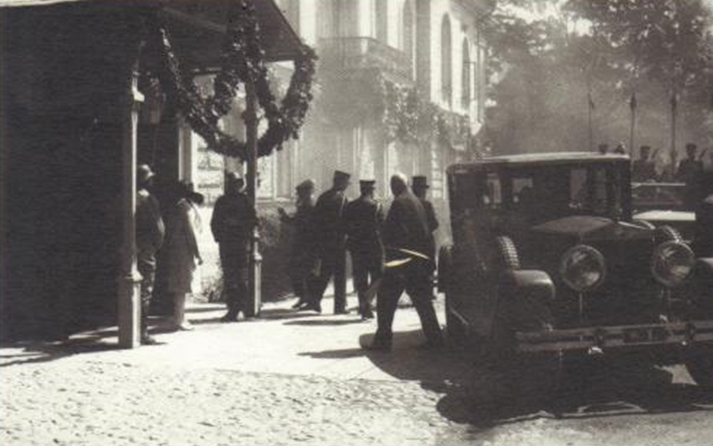
After Vilnius was occupied by the Russian Bolsheviks in 1919, the government of the Republic of Lithuania established its main base in Kaunas. Later, when the capital Vilnius was forcibly annexed by Poland, Kaunas became the temporary capital of Lithuania,a position it held until 28 October 1939, when the Red Army handed Vilnius back to Lithuania. Here a picture from the Presidential Palace of the Republic of Lithuania in Kaunas,
around 1930
At the end of World War I the Germans allowed the Vilnius Conference (18–22 September 1917) to convene (elections for a formal representative assembly were not permitted), demanding that Lithuanians declare loyalty to Germany and agree to an annexation. The Conference instead announced basic principles of a limited in territorial scope, but independent ethnic Lithuanian state, with cultural rights for the minorities; accordingly, the publication of the Conference's resolution was not allowed. The Conference elected a 20-member Council of Lithuania (Taryba) and empowered it to act as the executive authority of the Lithuanian people. The Council declared on 11 December Lithuanian independence as a German protectorate, and then adopted the outright Act of Independence of Lithuania on 16 February 1918. It proclaimed Lithuania as an independent republic, organized according to democratic principles. The Germans, still present in the country, did not support such a declaration and hindered attempts to establish actual independence. To prevent being incorporated into the German Empire, Lithuanians elected Monaco-born King Mindaugas II as the titular monarch of the Kingdom of Lithuania in July 1918. Mindaugas II never assumed the throne.
In the meantime, initially also under the German occupation, an attempt to revive the Grand Duchy of Lithuania as a socialist multinational federal republic took place. Anton Lutskevich and his Belarusian National Council proclaimed in March 1918 the Belarusian People's Republic, which was to stretch from the Baltic to the Black Sea and include Vilnius. Lutskevich and the Council fled the approaching Red Army and left Minsk before it was taken over by the Bolsheviks in December 1918. Upon their arrival in Vilnius, they proposed a Belarusian-Lithuanian federation, which however generated no interest on the part of the Lithuanian leaders, who were in advanced stages of promoting national plans of their own. The Lithuanians were interested only in a state "within ethnographic frontiers", as they perceived it.
Germany lost the war and signed the Armistice of Compiègne on 11 November 1918. Lithuanians quickly formed their first government, led by Augustinas Voldemaras, adopted a provisional constitution, and started organizing basic administrative structures. As the German army, defeated in the West, was withdrawing from the Eastern Front, it was followed by the Soviet forces, whose intention was to spread the global proletarian revolution. They created a number of puppet states, including on 16 December 1918 the Lithuanian Soviet Socialist Republic. By the end of December the Red Army reached Lithuanian borders, starting the Lithuanian–Soviet War.
On 1 January 1919 the German occupying army withdrew from Vilnius turning the city over to local Polish self-defense forces. The Lithuanian government evacuated Vilnius and moved west to Kaunas, which became the temporary capital of Lithuania. Vilnius was captured by the Soviet Red Army on 5 January 1919. As the Lithuanian army was in its infant stages, the Soviet forces moved largely unopposed and by mid-January 1919 controlled about ⅔ of the Lithuanian territory. Vilnius was now the capital of the Lithuanian Soviet Republic, and soon of the combined Lithuanian–Belarusian Soviet Republic.
From April 1919, the Lithuanian–Soviet War went parallel with the Polish–Soviet War. Polish troops captured Vilnius from the Soviets on 21 April 1919. Poland had territorial claims over Lithuania, especially the Vilnius Region, and these tensions spilled over into the Polish–Lithuanian War. Józef Piłsudski of Poland, seeking a Polish-Lithuanian federation, but unable to find common ground with Lithuanian politicians, in August 1919 made an unsuccessful attempt to overthrow the Lithuanian government in Kaunas.
In mid-May the Lithuanian army, commanded by General Silvestras Žukauskas, began an offensive against the Soviets in northeastern Lithuania. By the end of August 1919, the Soviets were pushed out of the Lithuanian territory. The Lithuanian army was then deployed against the paramilitary West Russian Volunteer Army, who invaded northern Lithuania. They were Germany-reactivated and supported German and Russian soldiers who sought to retain German control over the former Ober Ost. West Russian Volunteers were defeated and pushed out by the end of 1919. Thus the first phase of the Lithuanian Wars of Independence was over and Lithuanians could direct attention to internal affairs.
The Constituent Assembly of Lithuania was elected in April and first met in May 1920. In June it adopted the third provisional constitution and on 12 July 1920 signed the Soviet–Lithuanian Peace Treaty. In the treaty the Soviet Union recognized fully independent Lithuania and its claims to the disputed Vilnius Region; Lithuania secretly allowed the Soviet forces passage through its territory, as they moved against Poland.
On 14 July 1920, the advancing Soviet army captured Vilnius for a second time from Polish forces. However, they only handed the city over to Lithuanians on 26 August 1920, following the defeat of the Soviet offensive. The victorious Polish army returned and the Soviet–Lithuanian Treaty increased hostilities between Poland and Lithuania. To prevent further fighting, the Suwałki Agreement was signed on 7 October 1920; it left Vilnius on the Lithuanian side of the armistice line.[58] It had never gone into effect, because Polish General Lucjan Żeligowski, acting on Józef Piłsudski's orders, staged a military action presented as a mutiny. He invaded Lithuania on 8 October 1920, captured Vilnius the following day, and established a short-lived Republic of Central Lithuania on 12 October 1920. The "Republic" was a part of Piłsudski's federalist scheme, which was never to materialize, because of the opposition from both the Polish and Lithuanian (represented now by the Lithuanian government) nationalists. For 19 years, as the Vilnius Region had remained under Polish administration, Kaunas was the temporary capital of Lithuania. The League of Nations attempted to mediate the dispute and Paul Hymans proposed plans of a Polish–Lithuanian union. However, the negotiations broke down as neither side agreed to the compromise. Central Lithuania held a problematic election, boycotted by the Jews, Lithuanians and Belarusians, and was annexed into Poland on 24 March 1922.The Vilnius Region dispute was not legitimately resolved and Lithuania broke all relations with Poland. The two countries were officially at war over Vilnius, the historical capital of Lithuania, inhabited at that time largely by Polish-speaking and Jewish populations, between 1920 and 1938. The dispute continued to dominate Lithuanian domestic politics and foreign policy and doomed the relations with Poland for the entire interwar period.
Democratic Lithuania
The Constituent Assembly, which adjourned in October 1920 due to threats from Poland, gathered again and initiated many reforms needed in the new state: obtained international recognition and membership in the League of Nations, passed the law of land reform, introduced national currency litas, and adopted the final constitution in August 1922. Lithuania became a democratic state, with Seimas (parliament) elected by men and women for a three-year term. The Seimas elected the president. The First Seimas was elected in October 1922, but could not form a government as the votes split equally 38–38, and was forced to resign. Its only lasting achievement was the Klaipėda Revolt from 10-15 January 1923. Lithuania took advantage of the Ruhr Crisis and captured the Klaipėda Region, a territory detached from East Prussia according to the Treaty of Versailles, and placed under French administration. The region was incorporated as an autonomous district of Lithuania in May 1924. For Lithuania it was the only access to the Baltic Sea and an important industrial center. The Revolt was the last armed conflict in Lithuania before World War II. The Second Seimas, elected in May 1923, was the only Seimas in independent Lithuania that served the full term. The Seimas continued the land reform, introduced social support systems, started repaying foreign debt. Strides were made in education: the network of primary and secondary schools was expanded and first universities were established in Kaunas. A national census took place in 1923.
Authoritarian Lithuania
Antanas Smetona, the first and last president of independent Lithuania during the interbellum. The 1918–1939 period if often known as "Smetona's time".
The Third Seimas was elected in May 1926. For the first time Lithuanian Christian Democrats (krikdemai) lost their majority and became an opposition. It was sharply criticized for signing the Soviet–Lithuanian Non-Aggression Pact (Lithuanian claim to Poland-held Vilnius was recognized by the Soviets again)[61] and accused of "Bolshevization" of Lithuania. As a result of growing tensions, the government was deposed during the 1926 Lithuanian coup d'état in December. The coup, organized by the military, was supported by the Lithuanian Nationalists Union (tautininkai) and Lithuanian Christian Democrats. They installed Antanas Smetona as the President and Augustinas Voldemaras as the Prime Minister. Smetona suppressed the opposition and remained as an authoritarian leader until June 1940.
The Seimas thought that the coup was just a temporary measure and new elections should be called to return Lithuania to democracy. The legislative body was dissolved in May 1927. Later that year members of the Social Democrats and other leftist parties, named plečkaitininkai after their leader, tried to organize an uprising against Smetona but were quickly subdued. Voldemaras grew increasingly independent of Smetona and was forced to resign in 1929. Three times in 1930 and once in 1934 he unsuccessfully attempted to return to power. In May 1928 Smetona, without the Seimas, announced the fifth provisional constitution. It continued to claim that Lithuania is a democratic state and vastly increased powers of the President. His party, the Lithuanian Nationalist Union, steadily grew in size and importance. Smetona adopted the title of "tautos vadas" (leader of the nation) and slowly started building personality cult. Many of the prominent political figures married into Smetona's family (Juozas Tūbelis, Stasys Raštikis).
When the Nazi Party came into power in the Weimar Republic, Germany–Lithuania relations worsened considerably as Nazi Germany did not accept the loss of the Klaipėda Region. The Nazis sponsored anti-Lithuanian organizations in the region. In 1934, Lithuania put the activists on trial and sentenced about 100 people, including their leaders Ernst Neumann and Theodor von Sass. That prompted Germany, one of the main trade partners of Lithuania, to declare embargo of Lithuanian products. In response Lithuania shifted its exports to Great Britain. But that was not enough and peasants in Suvalkija organized strikes, which were violently suppressed. Smetona's prestige was damaged and in September 1936 he agreed to call the first elections to Seimas since the coup of 1926. Before the elections all political parties, except the National Union, were eliminated. Thus of the 49 members of the Fourth Seimas, 42 were from the National Union. It functioned as an advisory board to the President and in February 1938 adopted a new constitution, which granted the President even greater powers.
Lithuanian territorial issues 1939-1940
As tensions were rising in Europe following the annexation of Austria by Nazi Germany, Poland presented an ultimatum to Lithuania in March 1938. Poland demanded the re-establishment of normal diplomatic relations, which were broken after the Żeligowski's Mutiny in 1920, and threatened military actions in case of refusal. Lithuania, having a weaker military and unable to enlist international support for its cause, accepted the ultimatum. Lithuania–Poland relations somewhat normalized and the parties concluded treaties regarding railway transport, postal exchange, and other means of communication. Just a year after the Polish ultimatum and five days after the German occupation of Czechoslovakia, Lithuania received as oral ultimatum from Joachim von Ribbentrop demanding to cede the Klaipėda Region to Germany. Again, Lithuania was forced to accept. This triggered a political crisis in Lithuania and forced Smetona to form a new government which for the first time since 1926 included members of the opposition. The loss of Klaipėda was a major blow to Lithuanian economy and the country shifted to the sphere of German influence. When Germany and the Soviet Union concluded the Molotov–Ribbentrop Pact in 1939 and divided Eastern Europe into spheres of influence, Lithuania was, at first, assigned to Germany.
- Bookmark :
- Digg
- del.icio.us
- Stumbleupon
- Redit it
The interwar presidents
- Posted by - (0) Comment
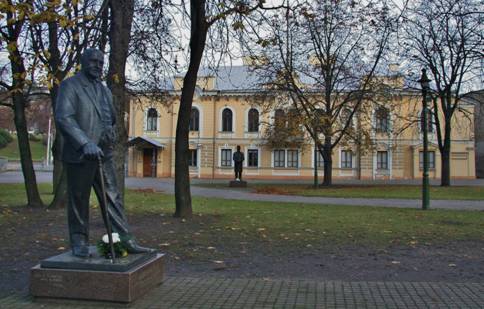
Statutes of the three interwar presidents are placed in the park in front of the Historical Presidential Palace in Kaunas. Picture: Statues of Aleksandras Stulginskis (front) and Antanas Smetona.
Photo: Aage Myhre
After Lithuania re-won its freedom in 1918, a Polish military invasion led to an annexation of eastern Lithuania (including the capital city Vilnius) to Poland. This was never recognized and Lithuania remained at a state of war with Poland, with the new government city Kaunas officially designated the “Temporary capital”. “We won’t calm down without Vilnius” became a popular slogan and organizations like the “Union for the Liberation of Vilnius” sprung up with the Lithuanian-Polish territorial dispute becoming one of the keystones of interwar Lithuania’s policy.
- Bookmark :
- Digg
- del.icio.us
- Stumbleupon
- Redit it
The interwar presidents
- Posted by - (0) Comment

Statutes
of the three interwar presidents are placed in the park in front of the
Historical Presidential Palace in Kaunas. Picture: Statues of Aleksandras
Stulginskis (front) and Antanas Smetona.
Photo:
Aage Myhre
After Lithuania re-won its freedom in 1918, a Polish military invasion led to an annexation of eastern Lithuania (including the capital city Vilnius) to Poland. This was never recognized and Lithuania remained at a state of war with Poland, with the new government city Kaunas officially designated the “Temporary capital”. “We won’t calm down without Vilnius” became a popular slogan and organizations like the “Union for the Liberation of Vilnius” sprung up with the Lithuanian-Polish territorial dispute becoming one of the keystones of interwar Lithuania’s policy.

Interwar
Lithuania strived to let the world know of its existence. Left is the art deco
Resurrection church, built to be the largest church in the Baltics and an
important landmark of rapidly expanding Kaunas. Right are Steponas Darius and
Stasys Girėnas, the first Lithuanian pilots to cross the Atlantic (1933). They
subsequently died in air disaster, becoming instant martyrs.
The main western powers recognized Lithuania only in 1922 as they preferred a stronger Poland to counter the German and Soviet threats. But by 1922 it was already clear that the Polish-Lithuanian Commonwealth would not be reborn as the Poles ceded many eastern lands to the Soviets in the Treaty of Riga.
Unlike the part of Lithuania that was in the Russian Empire, Lithuania Minor remained under German rule except for its northernmost part, the Klaipėda Region (German: Memelland), which was detached from Germany due to its Lithuanian majority. As the Lithuanian Republic was still unrecognized, Klaipėda Region remained under League of Nations rule. In 1923 Lithuania supported a revolt in Klaipėda Region and the new directory (government) of Edmonas Simonaitis joined Lithuania (as a bilingual autonomous area) thereby giving the young country its only seaport. Together with it came a sizeable German minority which caused trouble in the 1930s when the Nazi ideas caught on among the Germans of Klaipėda Region.
1926 saw a military coup with Antanas Smetona retaking presidential power. He ruled until the end of independent Lithuania, the period thus frequently known as the “Smetonic era”. Lithuania became one of the first authoritarian countries in the Eastern Europe, but by the year 1936 only a few, such as Czechoslovakia, would still remain democratic.

1926:
President Antanas Smetona takes oath before the Catholic bishop.
Interwar Lithuania continued to be an agricultural society with only 20% of people living in cities, therefore it was less heavily hit by the Global Depression, remained a devout Catholic land with the church not disestablished and the birth rates were still high (the population increased by 22% to over 3 million in years 1923-1939 despite the sizeable emigration primarily to the South America).
The foreign policy of Lithuania was friendly to the Germans and Soviets because many other countries, like France or Estonia, supported Poland in the conflict over Vilnius. However, the increasing imperialism of both Germany and the Soviet Union eroded their need for independent Lithuania. In 1939 German ultimatum led to the loss of Klaipėda Region. A secret Molotov-Ribentropp pact protocol included Lithuania in the German zone of influence, but the Smetona’s refusal to invade Poland together with Germany led to the change in the protocol with Lithuania being “ceded” to the Soviet Union. In 1939 Soviet Union established army bases in Lithuania after an ultimatum (this ultimatum also returned 1/5th of Vilnius region, recently occupied by the Soviets during their invasion of Poland), and another ultimatum in 1940 led to a full-scale occupation and annexation.
The interwar presidents
Antanas Smetona
|
|
Date and Place of Birth Family Professional
Qualifications Political, Public, Professional and Cultural Engagement Party Membership In Presidential Office April 6, 1919 – June 19, 1920 December 19, 1926 – June 15, 1940 Soviet occupation After Term of Office |
Alexander Stulginskis
|
|
Alexander Stulginskis (1885 02 26-1969 09 22) He was born Family Professional qualifications The political, social, professional and cultural activities Membership of political parties Office of the President At the end of this term |
Kazys Grinius
|
Kazys Grinius (1866 12 17-1950 06 04) He was born Family Professional qualifications The political, social, professional and cultural activities of Membership of political parties Office of the President At the end of this term |
- Bookmark :
- Digg
- del.icio.us
- Stumbleupon
- Redit it
- Posted by - (0) Comment
The Presidential Palace
in Kaunas is a must-see

Read more about the Palace at http://www.istorineprezidentura.lt/?lang=en
Photo: Aage Myhre
The Historical Presidential Palace in Kaunas is a must-see place for everyone, whether native-born or a visitor to Lithuania. It is one of the most important memorials of the Republic of Lithuania in 1918–1940.
Visitors are offered an introduction into the evolution of modern Lithuanian statehood, the opportunity to feel the pulse of a growing city that suddenly faced the challenge of becoming a capital and rapidly changed from a fortress into a modern city.
The building was at the centre of major political events of the time. It housed the President’s meetings with the Cabinet, as well as numerous meetings with the representatives of foreign countries, military, clergy and various organizations. It was a fundamental landmark of Foreign Policy; emissaries of foreign states here offered their credentials to the President of the Lithuanian Republic. The building also witnessed the Coup d’état of 1926, a crisis of parlamentarism and a turn towards authoritarian regime. In the face of imminent Soviet occupation, the Last Meeting of the government of the independent Lithuania took place here on the night from June 14 to 15 of 1940.
- Bookmark :
- Digg
- del.icio.us
- Stumbleupon
- Redit it
VilNews e-magazine is published in Vilnius, Lithuania. Editor-in-Chief: Mr. Aage Myhre. Inquires to the editors: editor@VilNews.com.
Code of Ethics: See Section 2 – about VilNews. VilNews is not responsible for content on external links/web pages.
HOW TO ADVERTISE IN VILNEWS.
All content is copyrighted © 2011. UAB ‘VilNews’.

 Click on the buttons to open and read each of VilNews' 18 sub-sections
Click on the buttons to open and read each of VilNews' 18 sub-sections 


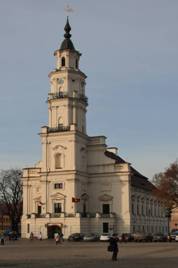
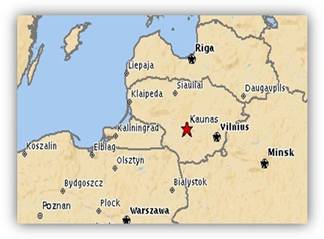

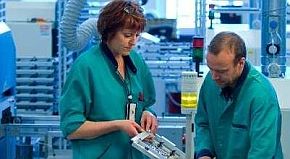






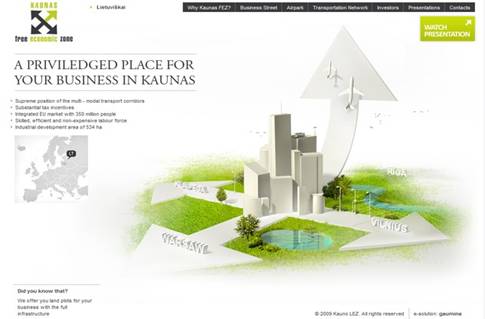








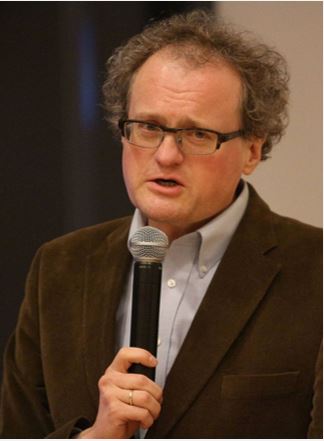
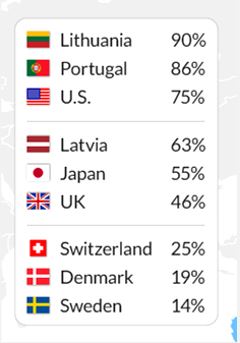
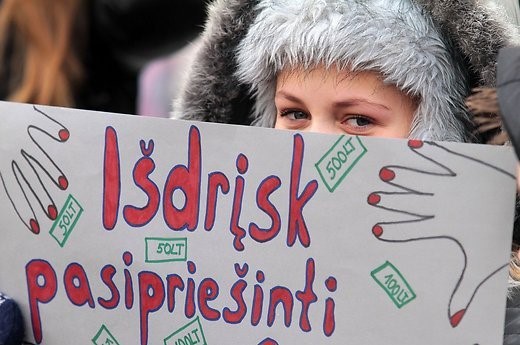


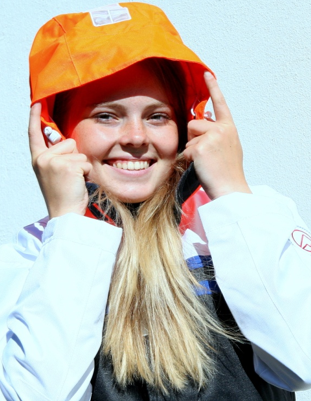
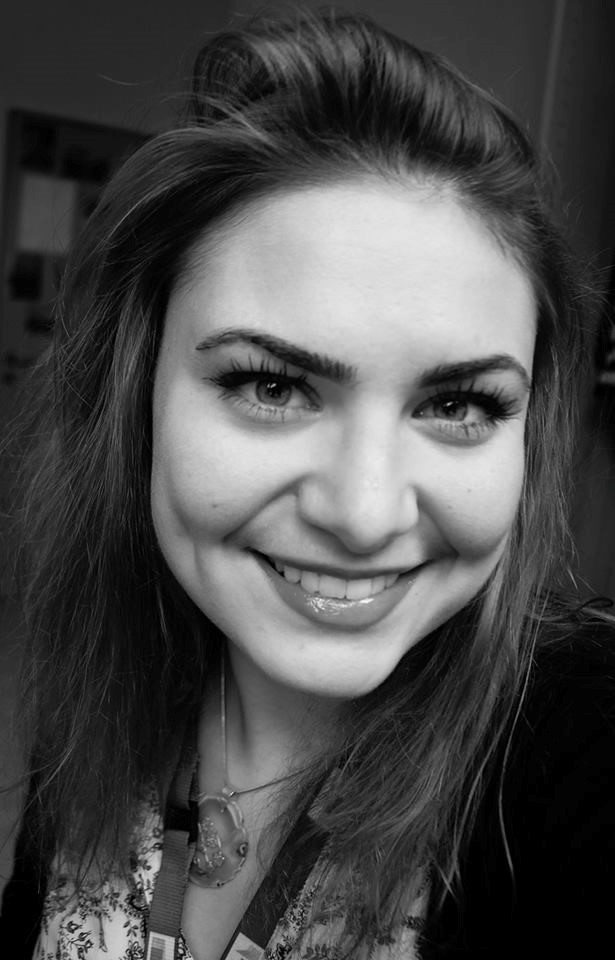
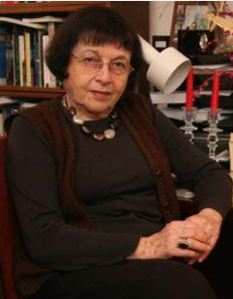
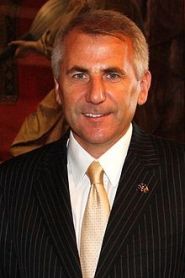
.jpg)
